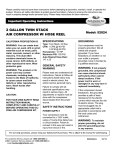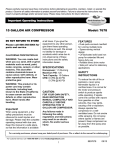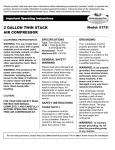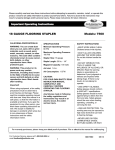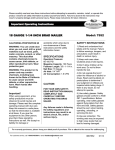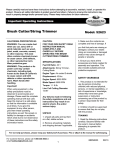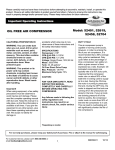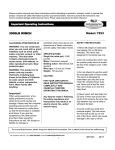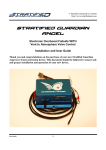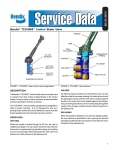Download SPEEDWAY 51850 Use and Care Manual
Transcript
60 GALLON COMPRESSOR CALIFORNIA PROPOSITION 65 Breathable Air Warning: WARNING: You can create dust when you cut, sand, drill or grind materials such as wood, paint, metal, concrete, cement, or other masonry. This dust often contains chemicals known to cause cancer, birth defects, or other reproductive harm. Wear protective gear. This compressor/pump is not equipped and should not be used “as is” to supply breathing quality air. For any application of air for human consumption, the air compressor/pump will need to be fitted with suitable inline safety and alarm equipment. This additional equipment is necessary to properly filter and purify the air to meet minimal specifications for Grade D breathing as described in Compressed Gas Association Commodity Specification G 7.1 - 1966, OSHA 29 CFR 1910. 134, and/or Canadian Standards Associations (CSA). WARNING: This product or its power cord may contain chemicals, including lead, known to the State of California to cause cancer and birth defects or other reproductive harm. Wash hands after handling. CAUTION: FOR YOUR OWN SAFETY READ INSTRUCTION MANUAL COMPLETELY AND CAREFULLY BEFORE OPERATING THIS COMPRESSOR. Failure to follow all instructions as listed below may result in electrical shock, fire, and/or serious personal injury. SPECIFICATIONS: Tank Size: 60 gallons CFM: 11.5 @ 40PSI; 10.2 @ 90 PSI Horsepower (Running): 3HP Max Pressure: 135 PSI Thermal overload protection [email protected] Model: 51850, 52332 SAFETY WARNINGS 1) Follow all electrical and safety codes along with National Electrical Codes (NEC) and Occupational Safety and Health Act (OSHA). 2) Electric motors and starters must be securely and properly grounded. 3) Do not allow the cable to come into contact with oil, grease, chemicals or sharp objects. Do not allow kinks to form in the cable. 4) Do not exceed the pressure limits for any component in or connected to the system. 5) Inspect the compressor to make sure that all the fittings, bolts, etc., are tight and secure before starting the compressor. 6) Do not touch the compressor or motor while it is in operation. These parts become HOT during 88051850 04/12 normal operation. Allow the unit to cool completely before performing maintenance or repairs. 7) Do not increase the settings on control components. These settings provide safety against over pressurization. The pressure switch settings are preset at the factory for normal operating conditions and increasing the settings will result in compressor and motor damage. 8) Regularly inspect the hoses, plugs, fittings, piping, wires, etc., for signs of damage, weakness or leakage before starting and using the compressor. 9) Fast moving air can stir up dust and debris, which may be harmful. Release the air slowly when draining moisture or depressurizing the unit. 10) Tanks rust and weaken with moisture. Ensure the tank is drained daily to avoid rust formation. 11) Inspect the air tank for rust, pin holes, cracks (especially in rear welds), bulges and other changes in the tank. 12) Never weld or drill holes in the air tank. 13) Keep others at a safe distance from the work area. [email protected] SPRAYING PRECAUTIONS 1) Always wear a respirator and safety glasses when spraying. 2) Always spray in an open, wellventilated area to prevent fumes from accumulating and causing fire and health hazards. Fumes are dangerous. 3) Do not spray materials near open flames and electrical equipment. 4) Do not smoke while spraying insecticides, paint or other flammable substances. 5) Do not direct paint or other sprayed material at the compressor. Make sure the compressor is as far away from the spraying area as possible to minimize overspray accumulation on the compressor. 6) When spraying solvents or chemicals, follow the instructions that are provided by the manufacturer. 7) Never use air pressurized accessories or parts in the air system that are not suitable for 135 PSI. When high humidity is present or when a compressor is used for an extended period of time, moisture will collect in the tank. This condensation can cause water droplets to appear in paint that is sprayed. To 2 eliminate this moisture, drain the tank often to reduce the buildup. A filter in the air line can help eliminate this moisture when it is located as near to the gun as possible. MAINTENANCE Before starting maintenance, ensure the air compressor is turned off, disconnected from the power source, the tank is drained and the compressor is cooled down completely. Daily: - Check oil level - Drain accumulated liquid from tank - Check for oil leaks - Check for unusual noise and/or vibrations - Check all fasteners are secure Weekly: - Check safety relief valve - Inspect and clean air filter - Clean breather holes on oil check dipstick Monthly: - Check for air leaks by applying a solution of soapy water around joints. Look for air bubbles around joints when the compressor reaches the pressure cut-out limit and pump turns off. -Check all nuts and bolts are tight -Check V-Belts for proper tension. -Check Compressor pulley and motor are aligned and securely fastened. How to Install a New Belt if Required 1) Disconnect power supply. Three months or 300 operating hours: - Change compressor oil (SAE 20 or 30) Replace oil more frequently when used in dusty operating environments. Initial Oil Change Due at 100 Hours. Checking Belt Tension (if belt driven) Adjust belt(s) so when pressure is applied at the center, there is approximately 1/2” slack Centre Distance 2) Remove belt guard. 3) Loosen motor bolts and slide motor toward compressor head just enough to allow old belt to be removed. 4) Install proper replacement belt. 5) Slide motor away from compressor head to provide recommended tension as shown in Figure A. 6) Align belt using a straight edge ruler against pulley’s edge. 7) Fasten motor bolts. 8) Ensure motor and compressor pulley’s are secure. Re-check alignment. 9) Re-install belt guard and reconnect power supply. FIGURE A Too Tight Slight Bow Correct Tension Too Loose 10) Belt tension should be checked after 20 hours of operation. Check tension monthly thereafter. If the belt is installed too tight, the motor may get overloaded. This will cause the motor to overheat. If the belt is installed too loosely, it will slip and excessive wear and vibration will occur. [email protected] 3 [email protected] 5 [email protected] 5 [email protected] 5






